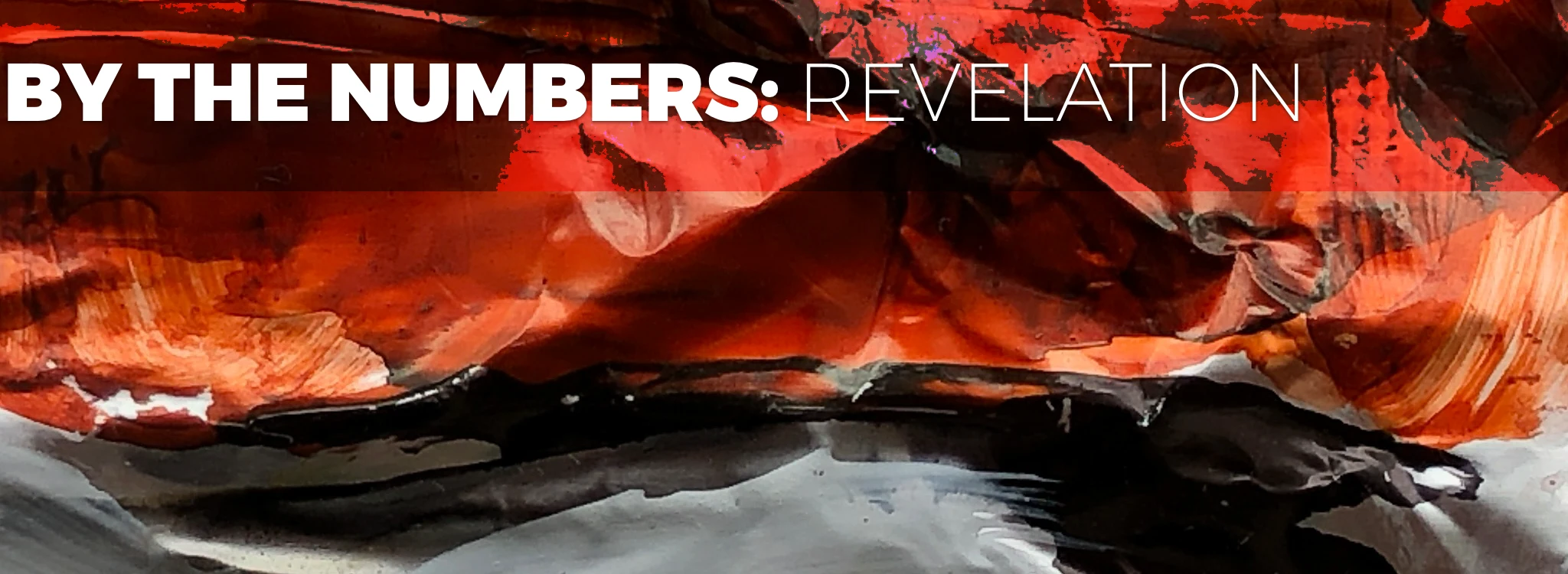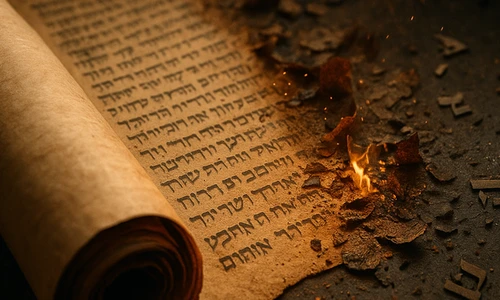Revelation by the Numbers: 5–24
This post is part of the series “Revelation by the Numbers”
-
Understanding the Sevens in Revelation
-
Revelation by the Numbers: 0–1
-
Revelation by the Numbers: 2–4
-
Revelation by the Numbers: 5–24 👈 you are here
-
Revelation by the Numbers: 30–1,260
-
Revelation by the Numbers: 1,600+
Introduction
This post is part of a series on the numbers in Revelation, John’s book of prophecy at the end of the Bible. It covers the numbers 5, 6, 8, 10, 12, and 24, including the pearly gates.
You can read all these entries in order, or feel free to skip around.
Note on Interpreting Revelation
Our first number: 2,000. That’s how many years theologians have been disagreeing wildly about the meaning of the visions in Revelation, primarily based on a disagreement about the timeline of the events described. Briefly, here are the major views:
- Preterist: The events of Revelation are mostly ancient, describing events leading up to the destruction of Jerusalem in 70 AD.
- Historicist: The events of Revelation are mostly historical, describing events throughout human history up to and including the present.
- Futurist: The events of Revelation are mostly future, describing events at some unknown time ahead.
- Idealist: The events of Revelation are mostly symbolic, taking place again and again at various times and on various scales throughout the life of the church.
My interpretations tend toward the futurist view for two reasons: first, the concrete interpretation of symbols in Scripture is fraught with danger unless we have a heavenly guide. Indeed, every attempt to attach every symbol of Revelation to a historical event results in making excuses for why the numbers don’t always work out perfectly (for example, try to find a definitive list of the 7 kings represented by the beast’s 7 heads in Revelation 17).
And second, the futurist view is sufficiently vague that it can mostly be applied to the preterist or historicist views with little alteration. That means that talking about most of Revelation from a futurist viewpoint covers the most ground. For example, there’s a beast in Revelation 13 that is clearly some sort of king or emperor. A preterist might say it stands for Nero Caesar. A historicist may say it stands for the Roman Empire or a Roman Catholic pope. A futurist would say it stands for some unknown ruler, which includes both of the other options. Therefore, by generally aligning with this view, we can study Revelation without blinding ourselves to other possibilities.
This viewpoint—the futurist one—may not be correct. As with all study of Scripture, you should do your own work and cover it in prayer. And as always, feel free to contact me if you have comments or questions.
The Numbers
5 Months of Torment
By locusts. Lots and lots of locusts.
And not just normal locusts. Locusts from the shaft of the bottomless pit. To which a fallen star was given the key. Upon the blowing of the fifth trumpet.
Then it gets weird.
The locusts can’t be just locusts, of course. Who gets tormented by locusts (except Egyptians, of course (Exodus 10:12–15)). No, these are the armored cavalry of the locust world:
In appearance the locusts were like horses prepared for battle: on their heads were what looked like crowns of gold; their faces were like human faces, their hair like women’s hair, and their teeth like lions’ teeth; they had breastplates like breastplates of iron, and the noise of their wings was like the noise of many chariots with horses rushing into battle.
Do they have weapons? Of course! What kind of cavalry doesn’t have weapons?
They have tails and stings like scorpions, and their power to hurt people for five months is in their tails.
I find myself incredibly curious about the duration here. Why 5 months? Other things in Revelation take 3 1/2 years, or 3 1/2 days. Half an hour. A thousand years. Other numbers are multiples of 7 and 12. Five, you may remember from school, is none of these things.
One reasonable guess is that 5 months is close to the summer active period for locusts; locust plagues (they’re actually called that!) can easily last that long, going through several generations of locust in that time. But it doesn’t make much sense as a symbolic value in John’s vision.
6 Wings of the Living Creatures
We’ve already discussed the 4 living creatures surrounding the throne of God singing “Holy, holy, holy” for eternity. And we discussed how we saw them back in Ezekiel, too.
One of the differences between Ezekiel’s creatures and John’s creatures is the number of wings: Ezekiel’s had 4, plus 2 arms; John’s have 6 (Revelation 4:8). (John doesn’t mention the arms.)
8 Kings of the Beast
When John is staring agape at the whore of Babylon, an angel explains the significance of the beast with 7 heads and 10 horns. The 7 heads, he says, are “seven kings, five of whom have fallen, one is, the other has not yet come, and when he does come he must remain only a little while” (Revelation 17:10).
As for the beast, he “is an eighth but it belongs to the seven, and it goes to destruction” (Revelation 17:11).
These kings are one of the most attractive siren calls for those who hold the preterist or historicist viewpoints of Revelation. Identifying the 7 kings and this 8th beast-king draws all kinds of answers. I’m not saying they’re wrong, only that it’s not clear that they’re obviously right, either.
For example, some historicists say the 7 kings are 7 forms of government of Rome: kings, consuls, dictators, decemvirs, military tribunes, military emperors, and… some unknown or transitional seventh form (the eighth, the beast itself, would be the papacy in this interpretation).
Some preterists prefer to say the 7 kings are specific men: Julius Caesar, Augustus, Tiberius, Caligula, Claudius, Nero, and Galba. Others leave off Julius and replace Galba with Vespasian. In both cases, you may notice that to get to 7, there are some missing.
That we can have so little clarity as to these identities, even knowing as much as we do about history, is what makes me so careful to avoid confidence in this area.
10 Days of Tribulation
John writes to the church in Smyrna that they should not fear, even though “for ten days [they] will have tribulation” (Revelation 2:10). John doesn’t help with the fear though, basically promising death in the next sentence: “Be faithful unto death, and I will give you the crown of life.”
The 10-day period is interesting. While the number 10 is somewhat common in Revelation (the next four entries are all about 10s), it doesn’t take on the same kind of significance as 7.
We can gain some insight by learning that much of John’s vision recalls Daniel’s visions. Right at the beginning of the book of Daniel (Daniel 1:8–16), we see Daniel refusing to eat the food the king offers him. He understands the political reality—he and his friends have been abducted in part to maintain the obedience of Israel to Babylon—and refuses to take part in it.
Concerned for Daniel’s health (and presumably his own, if Daniel were to grow weak and die), the steward urges Daniel to eat. Daniel suggests a test: he and his friends would eat only vegetables, and at the end of the test, the steward could compare them with the other prisoners to see who was healthier. Of course, Daniel and the others were healthier at the end of the test, and the steward permitted them to continue their fast.
That test lasted 10 days.
10 Horns of the Dragon
The dragon that appears along with the woman has 7 heads and 10 horns (Revelation 12:3). These horns represent power—10 horns is a lot of power.
10 Horns of the First Beast
The beast that arises out of the sea also has 7 heads and 10 horns (Revelation 13:1). The dragon gives the beast “his power and his throne and great authority”, and because of the beast, the world worships the dragon.
10 Diadems of the Beast
The dragon has 7 crowns, 1 for each head. This seems convenient, although I’ve wondered before how its 10 horns are distributed. But the beast from the sea, the first beast, has 10 crowns, 1 for each horn (Revelation 13:1).
These crowns are called in Greek diademata, which we translate as “diadems,” the type of crown a king would wear. So we can be reasonably confident in translating crowns to kings, especially considering that the angel in Revelation 17 explicitly tells John that the 7 heads represent 7 kings.
Therefore, these 10 diadems represent 10 kings. Which kings? Again, I don’t know. But we learn later that these 10 kings are permitted to rule for 1 hour only, and they hand over their power and authority to the beast (Revelation 17:12–13). The whole group of them foolishly make war on the Lamb, who of course conquers them so surely and thoroughly that John’s complete description of the battle is, “the Lamb will conquer them, for He is Lord of lords and King of kings” (Revelation 17:14).
10 Kings of the Beast
These 10 kings are the ones represented by the 10 diadems worn by the scarlet beast (Revelation 17:12). They are allowed 1 hour of authority; they hand their authority to the beast; the beast makes war on the Lamb; the Lamb crushes them all with a word.
Don’t mess with the Lamb.
12 Tribes of Israel
There are lots of 12s in the Bible. For example, there are 12 tribes of Israel, led by Jacob’s 12 children. Those children are conveniently listed in Deuteronomy 33 when Moses is blessing the tribes: Reuben, Simeon, Levi, Judah, Issachar, Zebulun, Dan, Naphtali, Gad, Asher, Joseph, and Benjamin1.
Recall that when Israel entered the Promised Land, Levi was not given territory: his descendants were priests, so they were given a few cities scattered throughout the territory. Joseph’s sons, Ephraim and Manasseh, were instead given land to bring the number of parcels back to 12.
But now in Revelation, John for some reason includes Manasseh and Joseph, but leaves out Dan entirely. I say “for some reason” because John doesn’t explain himself; he just lists the tribes and moves on (Revelation 7:5–8).
He has re-ordered them, as well. Judah, the tribe of David and Jesus, is listed first; this seems reasonable. Joseph and Benjamin are last, as they were originally. The other tribes come randomly: some parts are in birth order, but others are not.
In any case, 12,000 servants of God are sealed from each tribe, just before the angels holding back the natural disasters are permitted to bring destruction.
12 Stars of the Woman’s Crown
The woman in the sky, “clothed with the sun”, wears on her head a crown of 12 stars. From our earlier discussion of the 10 crowns of the beast, you may reasonably wonder which 12 kings they represent. From the discussion immediately above, you might reasonably conclude they represent 12 kings from each of the 12 tribes.
You would be sort of right. And sort of wrong.
Unfortunately, the English translation misleads you. The word translated “crown” in Revelation 12:1 is the Greek word stephanos, as opposed to the word translated “crown” a chapter later in Revelation 13:1, which is diademata. Kings wear diademata (diadems); a victor wears a stephanos.
So victory comes from these 12 stars, which you have correctly identified as the 12 tribes of Israel. But the victory comes through the Lamb, as we saw when he conquered the 10 kings and the beast without breaking a sweat2.
And we see that the woman gives birth to a son, “who is to rule all the nations with a rod of iron” (Revelation 12:5). We have seen this description already in Revelation, when John writes to Thyatira that
The one who conquers and who keeps my works until the end, to him I will give authority over the nations, and he will rule them with a rod of iron, as when earthen pots are broken in pieces, even as I myself have received authority from my Father.
These verses quote directly from Psalm 2:
I will tell of the decree:
The Lord said to me, “You are my Son;
today I have begotten you.
Ask of me, and I will make the nations your heritage,
and the ends of the earth your possession.
You shall break them with a rod of iron
and dash them in pieces like a potter’s vessel.”
The author of Hebrews uses the same psalm to explicitly identify Jesus:
For to which of the angels did God ever say,
“You are my Son,
today I have begotten you”?
So the woman’s son must be Jesus, the ultimate victor. But the woman is not Mary, the literal mother of Jesus. Mary would not wear all these crowns; she is definitely of the tribe of Judah. Jesus comes out of the full nation of Israel, and in Him all God’s people are victorious.
The woman is therefore not Mary but Israel. Israel of the 12 tribes. Israel of the wilderness.
This particular 12 is the key to understanding the entire image.
12 Gates of Pearl
Toward the end of the vision, John is shown the New Jerusalem, a gleaming, restored version of itself, protected by an enormous wall. In the wall are set 12 gates, 1 for each of the [tribes of Israel][#12-tribes-of-israel] (Revelation 21:12).
There’s a strained metaphor here about only gaining entrance to the heavenly city through one of the tribes of Israel; that is, only Jews would be permitted. But of course the gates of this city are never shut (Revelation 21:25): salvation, and the city, are open to all who believe. The nation of Israel can represent the people of the covenant, and of course Christians are the people of the new covenant, so they are welcomed through the gates.
John seems to run out of words to describe the beauty of this city. The walls have jewels embedded all over them, and these gates, he says, are each made of a single giant pearl (Revelation 21:21). You’ve heard this before, in the expression, “the pearly gates.” But you’re probably actually imagining a cloud with golden gates and a saint at a podium with a book.
Nope. First, there are 12 gates, not 1. Second, the gates are each made of a single pearl, not gold. Third, while these gates each have an angelic guard (not St. Peter), they are never closed: “its gates will never be shut by day—and there will be no night there” (Revelation 21:25).
The gates are inscribed with “the names of the twelve tribes of the sons of Israel” (Revelation 21:12), presumably the same 12 John listed earlier in Revelation 7. (By the way, Ezekiel saw 12 gates, too. He even tells us which names go on which sides (Ezekiel 48:30–34). Unfortunately, they’re not the same as John’s names in chapter 7.)
One more little detail about these gates: they are divided evenly among the walls of the city. Remember that the city is a square, so each side gets 3 gates (Revelation 21:13). This kind of organization reminds me strongly of Numbers 2, where the camp of Israel in the wilderness is described. The tabernacle is in the center, and on each of the 4 sides lay the camps of 3 tribes.
And here we are again. God has planned this end since the beginning, and He has given us glimpses of it all along.
12 Foundations of the City
The city of New Jerusalem tells the entire story of God from beginning to end. Its shape reflects the tabernacle and the temple, which themselves reflect Eden. Its gates represent the 12 tribes of Israel; its foundation stones represent the 12 apostles of Jesus (Revelation 21:14).
They’re also very pretty. John tells us that each foundation is covered in a different jewel: jasper, sapphire, agate, emerald, onyx, carnelian, chrysolite, beryl, topaz, chrysoprase, jacinth, and amethyst. If these names aren’t familiar to you, don’t worry: they’re just a translator’s best guess at which stones John was talking about. The precise identity of several of them is unknown. Early Greek translations such as the Septuagint heavily influence modern English translations. As a result, the English translations can be completely misleading; for example “topaz” could refer to any number of yellow stones, including chrysolite, which is also in the list, and which we now call peridot3.
Two jewels are conspicuously absent from the list: diamonds and rubies4. John certainly knew about rubies, although it’s possible he did not know about diamonds the way we think of them. Still, on a list of shiny stones to adorn the foundation of the city of God, their absence is weird.
12 Names of the Apostles
Each of the 12 foundations of the New Jerusalem represents an apostle, so of course their names are written on them.
Here’s my question. Judas betrays Jesus, thus becoming an ex-apostle. Later, the large group of disciples collectively choose Matthias to replace Judas so there are still 12 apostles. Then we never hear of Matthias again.
Until now. The 12 foundations have 12 names on them. Surely the name of Judas Iscariot, the betrayer of Christ, is not etched in the bejeweled foundation of the eternal city of God! Therefore, 1 foundation has Matthias’s name on it.
So Matthias appears in 0 gospels, exactly once in Acts, and then never again in all of Scripture—and his name shows up at the end of time. Forever.
It’s not an issue of fairness, but of significance: if Matthias were so faithful, so worthy, that not only did more than 100 disciples choose him (alongside Joseph) as the replacement for Judas, but God Himself (assuming God controlled the lots) agreed, where did he go? Why didn’t Paul write about him? Or James? Or John? One mention in the whole Bible—not even a story, just a name—yet also he is worthy of the foundation of the New Jerusalem.
Weird.
12 Kinds of Fruit
In the city, in the New Jerusalem, there is a street. Well, there are many streets, but one of them is special. In this street is a river. The “river of the water of life, bright as crystal” (Revelation 22:1). This river is the river that “[flows] from the throne of God and of the Lamb”—the same river Ezekiel measured that flowed from the temple (Ezekiel 47:1).
The river waters “the tree of life with its twelve kinds of fruit, yielding its fruit every month” (Revelation 22:2). This is a weird tree. By now, you should be used to weird things in Revelation, but still, this tree is unusual. Most trees have one kind of fruit—an apple tree, a pear tree, a banana tree. And the fruit tends to show up at a particular time: apples in the early fall; pears in the late summer; bananas as soon as they start looking yellow.
This tree has 12 kinds of fruit, and they are ready to eat year-round. Just as the river of the water of life offers infinite and eternal relief from thirst, this tree never lets you go hungry. The New Jerusalem is a place not of plenty but of extravagant excess: gates of pearl; jewel-encrusted foundations; all sun, no night; all God, no temple; and now a river that satisfies every thirst and a tree that defeats every hunger.
One more thing: trees and fruit should remind you of an old story, of another tree and another fruit, and a man and a woman and a serpent. But where that fruit was forbidden, this fruit is freely offered. Take and eat and taste and see.
24 Thrones Around the Throne
The idea of the “throne of God” is so familiar to Bible readers that it doesn’t seem to be strange at first. But what, exactly, does God look like, that He would need a throne?
Jesus the Son, the God-man, is a man who looks like a man and has the body of a man, and I know what a man sitting on a throne looks like. But God the Father looks like… you know what, I don’t know. Flashes of lightning, rumbles of thunder, fire and smoke and a still small voice. Not exactly things that need a throne, but Daniel and Ezekiel and John all saw thrones. Daniel writes, “the Ancient of Days took His seat” (Daniel 7:9, emphasis mine), and John sees “one seated on the throne” (Revelation 4:2) and I have trouble imagining the incorporeal Creator of the Universe sitting down and leaning back against… whatever could possibly uphold Him who upholds the Universe.
But you know who does need thrones? Basically everybody else. So John sees arranged around the throne of God 24 more thrones (Revelation 4:4), and it should be clear at this point where we are going. The holy city has 12 gates inscribed with the names of the 12 tribes of Israel, and 12 foundations etched with the names of the 12 apostles of Jesus. Can these 24 thrones be for anybody except these 24 people, the patriarchs and the apostles?
24 Elders with Crowns
Seated on those thrones are 24 elders, clothed in shining white and wearing crowds of gold (Revelation 4:4), whom we have identified as the 12 patriarchs and the 12 apostles.
Not, perhaps, literally those 24 men. For one thing, as we’ve discussed, there seems to be some confusion as to precisely which 12 men are the 12 patriarchs of Israel; and I’ve expressed my misgivings about the 12th apostle. For another, where are Noah, Abraham, Isaac, Jacob, Moses, David? Are they somehow unworthy to be seated in the throne room, the one good man before the flood, the fathers of the fathers (including the namesake of Israel), the prophet of the exodus, and the king after God’s own heart?
But the symbolism could not be more clear: 12 thrones for the law and the prophets, the nation of Israel who was God’s chosen people; and 12 thrones for the new covenant of water and blood, the apostles who birthed the church of Christ. That is, the entire following of God, the old and new covenants, surround the throne and worship Him who sits (or whatever) on it.
In response to the song of the living creatures, all 24 “fall down before him who is seated on the throne and worship him who lives forever and ever” (Revelation 4:10). They cast their crowns before Him, offering up whatever “glory and honor and power” they have in their positions as representatives of the people of God, singing instead “Worthy are you, our Lord and God” (Revelation 4:11) to receive those crowns and all they represent.
The entire creation bows down before the throne.
24 Elders with Harps
John’s first vision of Heaven is the throne of God surrounded by 24 thrones with 24 elders. But he and all of Heaven encounter a crisis: God holds a scroll, sealed with 7 seals, which nobody is worthy to open. John, confused, “began to weep loudly” (Revelation 5:4).
But he opens his eyes and sees a Lamb, and the Lamb is worthy, and the Lamb takes the scroll. And the 24 elders begin a new song.
Previously, the elders had crowns on their heads which they cast before the throne, singing, “Worthy are you, our Lord and God” (Revelation 4:11). But when the Lamb appears, the elders suddenly have harps and golden bowls of incense, “which are the prayers of the saints” (Revelation 5:8) (not to be confused with the bowls of wrath). And their song is to the Lamb: “Worthy are you…for you were slain, and by your blood you ransomed people for God” (Revelation 5:9).
God is worthy of praise for His creation, they say; and Christ is worthy of praise for redeeming that creation from the corruption of man.
Up Next
Next week’s installment of “Revelation by the Numbers” includes enormous hailstones, an even bigger wall, and the most famous number in the Bible.
You can read it now, and sign up for our newsletter below so you never miss a post.
-
Actually, the tribes are listed nineteen different times, and the number and order keeps changing. ↩
-
I guess, to be fair, before the Lamb was crucified, He did in fact sweat blood (Luke 22:44). ↩
-
Peridot is my mother’s birthstone, for August. Of course, there are 12 birthstones, but also of course, they have nothing at all to do with these stones. ↩
-
April and July, respectively. ↩
This post is part of the series “Revelation by the Numbers”
-
Understanding the Sevens in Revelation
-
Revelation by the Numbers: 0–1
-
Revelation by the Numbers: 2–4
-
Revelation by the Numbers: 5–24 👈 you are here
-
Revelation by the Numbers: 30–1,260
-
Revelation by the Numbers: 1,600+




